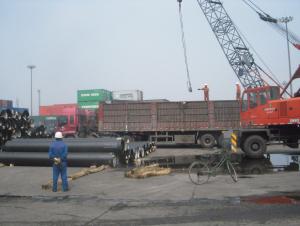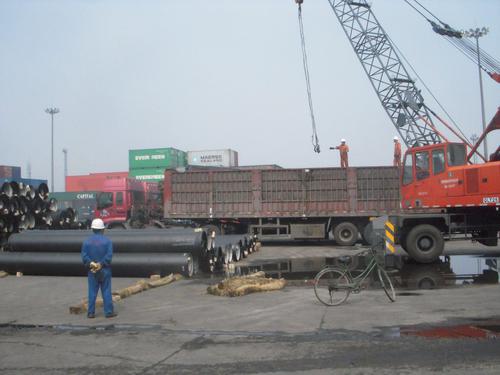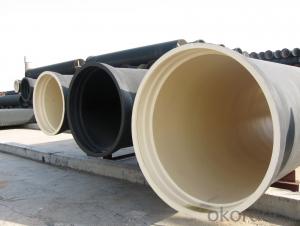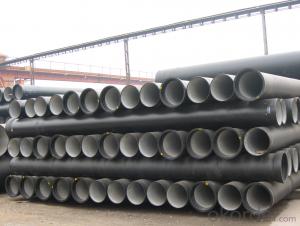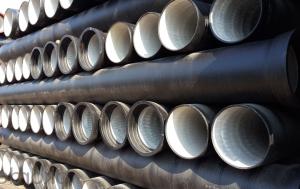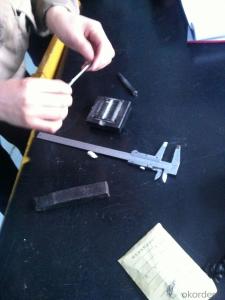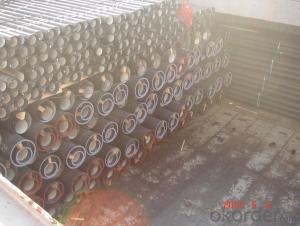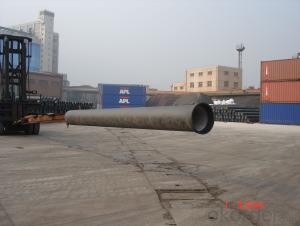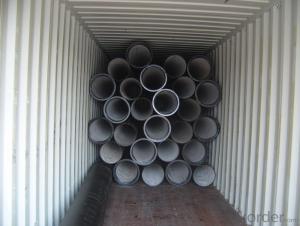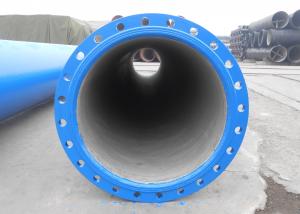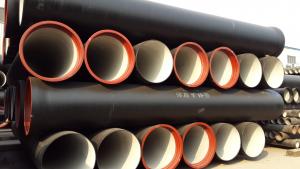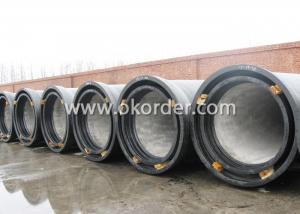DUCTILE IRON PIPES AND PIPE FITTINGS K8 CLASS DN300
- Loading Port:
- Tianjin
- Payment Terms:
- TT OR LC
- Min Order Qty:
- 22 pc
- Supply Capability:
- 3000 pc/month
OKorder Service Pledge
OKorder Financial Service
You Might Also Like
Material : Ductile Cast Iron
Size Range : DN 80mm to DN 2000mm
Unit Effective Length : 6m or 5.7m
Manufacture Standard: ISO 2531:1998/ EN 545:2006/EN 598:2007
Annual capacity : 200,000 tons
Coating Exterior: Zinc 130g/m2 according to ISO 8179-1 and bitumen coating 70 microns.
Cement Interior: Portland Cement/ High Alumina Cement/ Sulphate Resisting Cement Lining according to ISO 4179
Special requirements on external coating and internal lining can be applied
We also provide accessories such as SBR/EPDM rubber gaskets, lubricant paste, pipe caps, PE sleeves, etc.
Additional Parts:
Each pipe is strictly inspected according to related standard to ensure permanently high performance.
Easy Installation at site and service free for life
Long Service Lifespan
Quotation will arrive you within 24hours once we get your inquiry.
We guarantee offering you a competitive price.
A copy of original inspection reports of pipes will be offered after shipment.
Photos of loading process will be sent to the customer after shipment effect.
We will follow-up the delivery progress after shipment effect and update to the customer on weekly basis.
- Q: Are ductile iron pipes resistant to hydrostatic pressure?
- Yes, ductile iron pipes are resistant to hydrostatic pressure. They have the ability to withstand high water pressure without deforming or bursting, making them a reliable choice for applications involving the transportation of water and other fluids.
- Q: The difference between ductile cast iron pipe and machine-made cast iron pipe
- Production process is different, ductile iron pipe mainly through intermediate frequency furnace heating, annealing, and then do cement lining cement lining production, the mechanism of cast iron pipe does not make cement lining.
- Q: What is the expected noise reduction of ductile iron pipes?
- The expected noise reduction of ductile iron pipes can vary depending on several factors, including the specific characteristics of the pipe material and design, the installation method, and the surrounding environment. However, generally speaking, ductile iron pipes have been found to provide significant noise reduction compared to other pipe materials. Ductile iron pipes are known for their superior acoustic performance due to their dense and robust construction. The material's high density helps to absorb and dampen noise vibrations, reducing the transmission of sound waves through the pipe. Additionally, the smooth internal surface of ductile iron pipes minimizes turbulence and friction, further contributing to noise reduction. Various studies and field tests have shown that ductile iron pipes can achieve noise reductions ranging from 10 to 20 decibels (dB) or even higher, depending on specific conditions. These noise reductions can significantly improve the acoustic environment in areas where the pipes are used, such as residential areas, hospitals, or schools. It is important to note that while ductile iron pipes can provide substantial noise reduction, other factors such as pipe connections, fittings, and valves can affect the overall acoustic performance. Proper installation techniques, including the use of effective seals and dampers, can further enhance noise reduction. In conclusion, ductile iron pipes are expected to deliver notable noise reduction benefits due to their dense construction, smooth internal surface, and efficient installation methods. However, it is essential to consider the specific project requirements and consult with professionals to determine the expected noise reduction levels based on the particular circumstances.
- Q: How does ductile iron pipe perform in high-temperature steam applications?
- Ductile iron pipe performs quite well in high-temperature steam applications. Ductile iron is a strong and durable material, known for its ability to withstand high pressures and temperatures. When exposed to high-temperature steam, ductile iron pipes maintain their structural integrity and do not deform or crack easily. They have a high resistance to thermal expansion and contraction, making them suitable for applications where temperature variations are common. Additionally, ductile iron pipes have excellent corrosion resistance, which is especially important in steam applications where the presence of moisture can lead to accelerated corrosion. Overall, ductile iron pipes are a reliable choice for high-temperature steam applications, providing long-lasting performance and ensuring the safe and efficient transportation of steam.
- Q: Are ductile iron pipes suitable for installation in areas with high soil compaction?
- Indeed, areas with high soil compaction can accommodate the installation of ductile iron pipes. Renowned for their robustness and longevity, ductile iron pipes exhibit remarkable resistance against external loads and pressures. Their inherent pliability enables them to endure the strains caused by intense soil compaction. Furthermore, ductile iron pipes possess a substantial modulus of elasticity, enabling them to retain their form and structural soundness even when subjected to substantial burdens. Consequently, they present themselves as an exceptional option for regions with high soil compaction, as they adeptly manage the force and deliver dependable and enduring functionality.
- Q: What is the weight of ductile iron pipes compared to other materials?
- Ductile iron pipes are generally heavier than other commonly used materials such as PVC or HDPE pipes.
- Q: What is the expected bedding and backfill requirements for ductile iron pipes?
- To ensure the longevity and proper functioning of ductile iron pipes, it is crucial to meet the expected bedding and backfill requirements. Although these pipes are known for their durability and strength, careful installation is still necessary to prevent any potential damage or compromised performance. The bedding requirements for ductile iron pipes entail establishing a stable and uniform support system to distribute the loads and stresses from the surrounding soil. The pipe should be surrounded by a bedding material that is devoid of rocks, debris, or any sharp objects that could potentially cause harm. Moreover, the bedding material should be adequately compacted to prevent settlement or shifting, which could result in misalignment or pipe failure. Typically, a granular material such as sand or fine aggregate is employed as the bedding material for ductile iron pipes, with a minimum thickness of 6 inches. This material should be evenly placed beneath and around the pipe to provide a continuous support system. Additionally, it should be compacted to at least 90% of the maximum dry density to ensure proper stability and load distribution. As for the backfill requirements, they pertain to the material used to fill the remaining space around the pipe after the bedding has been installed. Similar to the bedding material, the backfill material should be free from rocks, debris, or sharp objects to prevent damage. It should offer support and protection to the pipe while allowing for proper compaction and settling. The backfill material for ductile iron pipes typically consists of a granular substance such as sand or fine aggregate, with a maximum particle size of 1 inch. It should be placed and compacted in layers, ensuring that the compaction is uniform and even around the pipe. Sufficient compaction is crucial to avoid settlement or shifting of the backfill material, which could potentially harm or misalign the pipe. In conclusion, meeting the expected bedding and backfill requirements for ductile iron pipes necessitates the use of a granular material that is free from rocks, debris, or sharp objects. This material should be evenly placed and compacted to provide stable support and protection to the pipe. Adhering to these requirements will help ensure the proper functioning and longevity of ductile iron pipe systems.
- Q: Are ductile iron pipes resistant to chemicals?
- Yes, ductile iron pipes are generally resistant to chemicals. Ductile iron is a type of cast iron that has been alloyed with small amounts of magnesium to improve its strength and ductility. This alloying process enhances its resistance to corrosion and chemical attack. Ductile iron pipes have been widely used in various applications including water supply, wastewater treatment, and industrial piping systems where they may come into contact with a variety of chemicals. However, it is important to note that the resistance of ductile iron pipes to chemicals can vary depending on the specific type and concentration of the chemical involved. Therefore, it is advisable to consult the manufacturer or a qualified engineer to determine if ductile iron pipes are suitable for a particular chemical application.
- Q: What are the common causes of failure in ductile iron pipes?
- There are several common causes of failure in ductile iron pipes. One major cause is corrosion. Over time, the exposure to water, soil, and other environmental factors can lead to the formation of rust and corrosion on the pipe's surface. This can weaken the structural integrity of the pipe and eventually lead to failure. Another common cause is improper installation or handling. If the pipes are not installed correctly or if they are mishandled during transportation or installation, it can result in cracks, fractures, or other physical damage. These defects can compromise the functionality of the pipe and contribute to its failure. Inadequate design is another factor that can lead to failure. If the pipe is not designed to withstand the anticipated loads, pressures, or environmental conditions, it can become susceptible to premature failure. The pipe's material properties, wall thickness, and diameter must be carefully considered during the design process to ensure it can handle the expected demands. Poor maintenance and lack of timely repairs can also contribute to failure. Regular inspections, maintenance, and prompt repairs are necessary to identify and address any issues before they escalate. Failure to do so can result in the gradual deterioration of the pipe, making it more prone to failure. Lastly, external factors such as soil movement, seismic activity, or excessive traffic loads can also cause failure in ductile iron pipes. These external forces can exert stress on the pipe, leading to cracks, fractures, or even complete failure. To prevent failure in ductile iron pipes, it is essential to employ proper corrosion protection techniques, follow correct installation procedures, ensure adequate design considerations, implement regular maintenance and repair programs, and account for external factors during the planning and installation process.
- Q: Can ductile iron pipes be used in areas with high levels of groundwater contamination?
- Ductile iron pipes can be used in areas with high levels of groundwater contamination. Ductile iron is a strong and durable material that is resistant to corrosion, making it suitable for various environments, including those with contaminated groundwater. It offers a high level of resistance to chemicals and can withstand the corrosive effects of contaminants that may be present in the groundwater. Additionally, ductile iron pipes have a protective lining which further enhances their resistance to corrosion. However, it is important to note that the suitability of ductile iron pipes in such areas also depends on the specific nature and concentration of contaminants present in the groundwater. Consultation with experts and adherence to local regulations and industry standards is crucial to ensure the appropriate selection and installation of pipes for areas with high levels of groundwater contamination.
Send your message to us
DUCTILE IRON PIPES AND PIPE FITTINGS K8 CLASS DN300
- Loading Port:
- Tianjin
- Payment Terms:
- TT OR LC
- Min Order Qty:
- 22 pc
- Supply Capability:
- 3000 pc/month
OKorder Service Pledge
OKorder Financial Service
Similar products
Hot products
Hot Searches
Related keywords
